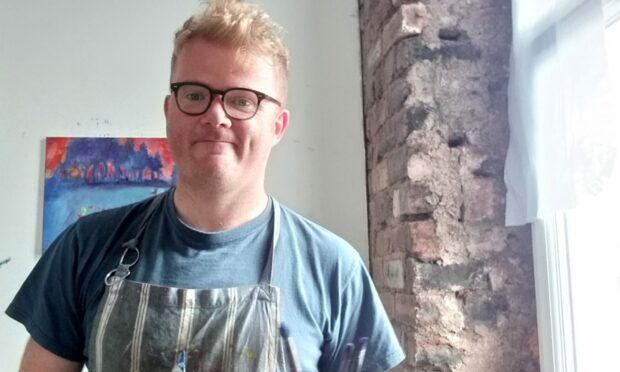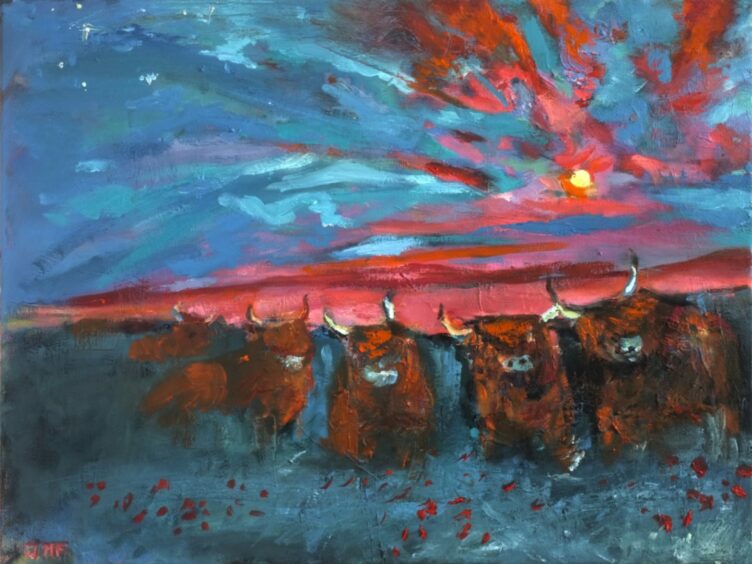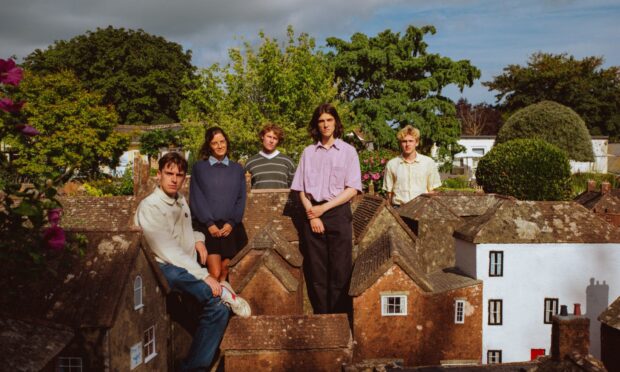John Martin Fulton knew from a young age that he wanted to be an artist.
Growing up in Coatbridge, his early passion and focus took him to Glasgow School of Art.
Graduating in 2004, he was awarded a scholarship to study in Florence from the Royal Scottish Academy.
‘Everyone has ability to draw and paint’
But when the now 40-year-old reflects on his career and the awards he’s won over the years, he insists he’s not an “amazingly talented” artist.
By contrast, he thinks everyone has the ability to draw and paint.
People just need the opportunity to express themselves and be encouraged.
It’s a conclusion he’s reached after working with community groups from deprived areas of Scotland – including a post-Covid-19 initiative that recently brought him to Dundee.
Dundee ‘Culture Collective’
“I’m a gallery artist – I do my own paintings – but I also do loads of social community art,” he said in an interview with The Courier.
“I work with refugee groups, people in recovery from addiction, kids – loads of different types of groups.
“I’ve done that for about 10 years.
“Through that I’ve been involved with this big national thing called Culture Collective.
“Artists have worked with community groups from different deprived areas.
“The ones from all over Scotland met up at the DCA for a couple of days last year.
“It was like a Covid recovery thing where they were creating these networks for artists to get us all out working again while being beneficial to communities.
“But it reminded me that as kids we all draw and paint. Everyone is a natural.
“I don’t think anyone is particularly good and others particularly bad at drawing and painting. We just need focus and encouragement.”
First featured show at Gallery Q
John has exhibited in mixed group shows at Gallery Q in Dundee, before.
However, the exhibition that recently ran at the Nethergate gallery, was the first time he’s been the featured artist.
It’s a development he finds “quite exciting”.
Bold and expressive, his new work reflects his interest in ‘Scottishness” through European Expressionism and children.
Influence has also come from now being the father of his own two children, aged four and six.
“My paintings come under the title ‘Children of Scotland’ series,” he said.
“They are expressive paintings of children in Scotland that combine my loves of Scottish culture, kids – I have two wee ones – and European Expressionist painting.
“My driving force is the humanity that art can make us feel.
“What people feel when they see the children in my paintings and my own humanity expressed when I paint them with as much feeling as I can.
“The children in my pictures are imaginary and they exist in an invented Scotland.
“I owe lots to a feeling of Scottish-ness and I am fascinated by the idea of a uniquely Scottish tradition in painting.”
Influence of fatherhood and Joan Eardley
John explained that he started painting children as soon as he became a father.
But he’d always loved paintings with children in them, especially those of Joan Eardley who painted weans living in post-war Glasgow.
When he sees a child in a painting he can sympathise and relate to them in a direct way.
There’s none of the politics (of power and sex) that you get with adults.
They can just exist in the world of the painting.
He’s always had really deep feelings for the paintings of Joan Eardley who painted children living just down the road from where he lives, in the Townhead area of Glasgow, in the 1950s.
Meanwhile, the Scottish theme is influenced by simply being a Scot and bringing identifiable Scottish objects into his work.
It’s a big part of his identity and part of what he wants to say with paint.
Scotland’s landscape is gorgeous.
But what is more beautiful for him is the humanity, the kindness and openness, of the people who live here.
Influence of Glasgow School of Art
John’s influences have come from several directions.
After Glasgow School of Art where he was schooled in the arts of figurative drawing, his Florence scholarship gave him the confidence that he could keep doing art after art school.
However, he had a brief change of direction in his 20s.
Finding it to be a lonely existence in the studio trying to paint all the time, he did a Masters in newspaper journalism in Nottingham.
He then worked in local newspapers for four years – the weekly Irvine Times in Ayrshire.
However, after deciding he’d “done enough of that”, he moved on to work part-time in the office of a social care charity, leaving enough time for him to also get back into painting.
After a while, he was keen to get involved with art workshops, working with people in addiction services and with learning disabilities.
He enjoyed finding a place “where art meets life”.
It was then that he was really struck by a feeling that art is often “missing” from everyday life.
Art should be available to all
“Art is something that should be open to everybody,” he said.
“I wouldn’t look back and say I was this amazingly talented person.
“I got the chance to find out what I wanted to express and kind of explore that.
“It just seems like the fairest thing to give everybody the chance to do art.
“When I do workshops I’m just passing on a lot of my art school education to people who wouldn’t normally be exposed to that.
“But they are just as good as art. If they are given the chance.
“Most people enjoy painting or drawing and find it therapeutic after a wee while.”
How does John approach painting?
John starts his paintings with no model or photograph.
For him that’s the only way he feels “totally free” – as an artist working on instinct.
He’s thrilled by the idea that the first humans painted beautiful, tender pictures on the walls of caves before they had language.
When he was at Glasgow School of Art there was still a big emphasis on life drawing and students would spend weeks at a time in the life room.
All that knowledge of drawing and painting figures is in him.
But he’s also been heavily influenced by painters from Scotland.
“Even at high school, when I was first beginning to feel like I was an artist, I remember being most excited by painters from Scotland – Glasgow in fact,” he added.
“Painters like Gaugin, Van Gogh and Egon Scheiele were obviously mesmerising but the idea that people like Ken Currie and Peter Howson were creating profound work in Glasgow and that they were not from the past but actually alive and working.
“Well, that was a bolt of lightning!”
Celebration of colour
Going to Glasgow School of Art straight from school, he was delighted to be in what felt like the hub of this painting tradition.
“I loved to think that artists like Joan Eardley, MacBryde and Colquhoun, Peter Howson and Ken Currie had all been there before me, struggling and forging what painting in Scotland could be,” he said.
“I also discovered the German Expressionists when I was there – Ernst Ludwig Kirchner, Max Beckman etc – and saw how they had shown their turbulent society in brightly coloured, raw paintings.
“I remember writing a dissertation where I was desperate to try to understand what a peculiarly Scottish tradition of painting could be.
“What were its defining characteristics? Where had it came from?
“I think I concluded that a kind of northern European angst, maybe from living in cold dark country, was central.
“But also there was a celebration of colour, a joie de vivre shared with the other Gaels of France.
“I suppose it’s hard to pin down, especially in today’s interconnected world, but it’s something felt anyway.
“What is a painting if it isn’t just colour?
“It should be bright and colourful!”
John is also inspired by all the artists he loves.
“If I see a reproduction of a Van Gogh it just seems obvious that we need to try and keep doing something like that because we still find it so beautiful,” he added.
“In today’s world of smart phones, fleeting images and throwaway culture it just seems important to try to get something direct, from inside a human spirit, expressed out.
“The urge to paint is older than anything we can touch – I’m just following my human nature.”
Gallery Q exhibition
Alongside John Martin, as previewed by The Courier, Gallery Q was exhibiting a mix of works.
These included still life from Fiona Sturrock, industrial townscapes from Lindsey Lavender, imagined narratives from Kate Bentley RI, bird studies from Helen Welsh and local scenes from Charlie Parsons.
The exhibition ran at Gallery Q, Nethergate, Dundee, until June 3.


















Conversation